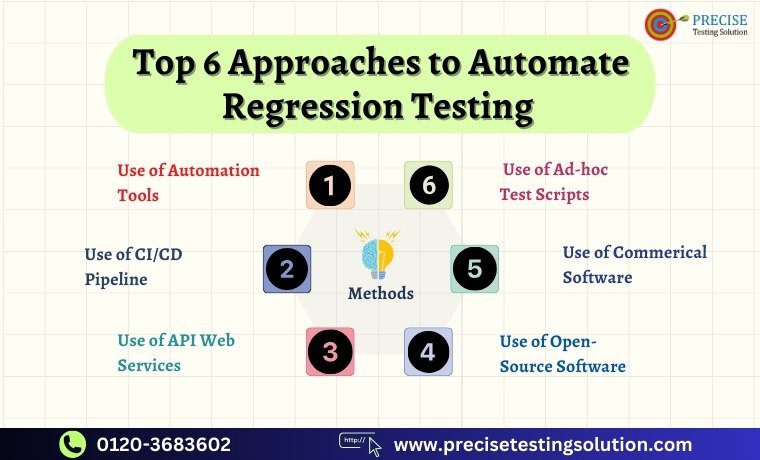Importance of Automated Regression Testing
Regression testing must eventually be put into practice to make sure that any new modifications or upgrades to the software haven’t broken other components. The intricate nature of the application will develop along with the size of the company that uses it. Although manual regression testing can be time-consuming, there are several ways to automate this entire process using different tools and technologies. In this blog post, we’ll go over the six active ways for automating the entire process of regression testing that are most frequently used.
Let’s Begin!
Top 6 active methods to perform Automated Regression Testing
1. Use of Automation Tools: The test engineers can use a series of automation tools to automate a series of tests for a particular set of applications. Performance and load testing are two examples of non-functional tests that can be carried out using these kinds of tools. Many steps in the regression testing process of creating a test-suite can be automated, including creating scripts and running tests, depending on the tool and they may provide the findings right away. Selenium, Katalon Studio, Ranorex Studio, Performance Lab, Watir etc are some of the most popular automation testing tools that are used by automation test engineers to perform automated regression testing.
2. Use of CI/CD Pipeline: Continuous integration (CI) is the automated daily merging of all developer working copies to a single shared mainline. When automating regression testing by starting unit tests automatically whenever code changes are committed to source control, CI servers are advantageous because they are often geared for automation. Contrarily, in continuous development, an agile software development method, teams create new features every day or every week. Instead of performing manual regression testing at the end of the development period, this can be paired with continuous integration to automate regression testing and enable DevOps teams to test new code as it is being reproduced.
3. Use of API Web Services: To test an application or other components that comprise the architecture that the application interfaces with, it’s possible to actively use web services such as SOAP, RESTful, and JSON. Regression testing can be automated by repeatedly executing tests that interact with these online services through a script interface (for example, Python).
4. Use of Open-Source Software: The individuals who develop open-source software (OSS) typically make their source code available for free to anyone who wants to use or change the application because they do it for fun rather than for financial gain. Many open-source projects have previously created regression testing tools that you can use as a starting point when developing your own automated tools. Although these tools for regression testing will have a wide variety of capabilities and restrictions, they will probably be able to automate at least some of your regression tests.
5. Use of Commercial Software: Regression testing can be automated using a variety of commercial tools that are available online or through conventional retail channels (such as a shrink-wrap application). While some of these programmes have an open API that may be used to build unique tools, others might have a more constrained feature set that only performs certain tasks. In any event, you must select commercial software based on your requirements and financial situation.
6. Use of Ad-hoc Test Scripts: Finally, the automation test engineers may also automate regression testing by manually creating and running the tests using a scripting language. For instance, to run the tests, when necessary, at any time without involving other people, a developer may use a scripting language in their IDE or an administrator in a CI server’s build script.
Conclusion
Hence, from the above discussion, we can conclude this blog post by saying that the practice of automated regression testing must eventually be chosen for your regression tests. Always keep in mind that automation is not free. Choose the appropriate tools for the task at hand because mastering the use of a tool takes time and effort. If you are unable to make this time or financial commitment, manual testing may still be your best option, but to save time and effort, try to automate as much of your regression testing as you can.
Contact Precise Testing Solution and schedule an online consultation with our expert team of QA engineers. We do extensive regression testing both manually and using popular automation tools like Selenium that will assist you in the verification and validation of each bug in your software product that gets fixed, in addition to providing you with immediate improvement by thoroughly eradicating them to prevent further system failures in the future. Being the only company in India that is accredited by both STQC and CERT-IN, we are a reputable and independent software company offering ready-made solutions with powerful features such as extensive test management, user administration, and security.
For more information, visit our website at www.precisetestingsolution.com or call our office @ 0120-3683602.
Also, you can send us an email at [email protected]
We look forward to helping you!
How to Identify Email Spoofing Attempts
What Is The History Of Spoofing Spoofing, in the
A Comprehensive Guide to Optimizing Your A/B Testing
What is A/B testing? Also known as split A/B



